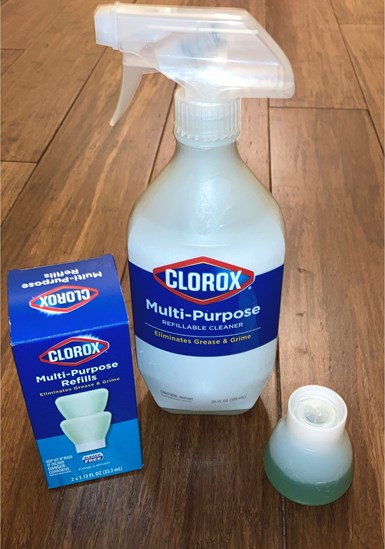
Smart Container Design Reduces the Need for Containers
The widely adopted recycling goal of 30% is an ambitious step up from where we are today. But even if this milestone is reached, increased production will require massive investment in waste management infrastructure. If production doubles, the 70% that is not being recycled could exceed today’s total production by hundreds of millions of tons.
Container design that reduces need could ameliorate some of this loading.

Clorox refillable multi-purpose spray and refill.
Photo Credit: Matt Stonecash
Clorox’s multi-purpose refillable cleaner is one such design. The kit is alarmingly light weight, I thought the box was empty when I first picked it up. Inside is an empty (HDPE) spray bottle that weighs 3 ounces and a pod of concentrated cleaning solution that weighs about an ounce and a half (around one ounce of solution and 0.5 ounces of HDPE).
Missing is the 20 ounces of water included with competing products. The most immediately obvious benefit is the energy savings gained by shipping a product that weighs far less per unit, by not shipping customers water that they have easy access to at the nearest faucet, at negligible cost. That’s just the beginning. Packaging weight per refill is about ¾ of an ounce (two pods are packaged together in a thin cardboard container).
The Pros and Cons of Using a Refillable Household Product
If someone used this product once and threw it out, they would of course be using more plastic than they would if they simply bought a disposable container. This might happen if they find the refill procedure too complex. To refill, the spray cap is unscrewed, the bottle is filled with water to a marked line, the refill pod is screwed to the bottle (automatically releasing its contents), the pod is removed from the bottle, and the spray cap is placed back on. It could take about 20 seconds.
If adopted widely, a refillable version of a widely used product like this one could have considerable impact. Clorox believes the spray bottle will last around 8 refill cycles, for a plastic use reduction of 80%. Fatigue of the spray mechanism itself is the limiting factor. I have gotten several years of use out of “disposable” bottles of similar design refilled with homemade solution.
It remains to be seen if this product will take hold and if other product lines or other brands will move in the refillable direction. But I was relieved to learn that the replacement pods are still available, so I will not be turning back to a disposable version any time soon.
Here is a sustainability opportunity that plastic packaging design can be part of: why truck large quantities of water across a country that is very well equipped with pipes?
RELATED CONTENT
-
Life Cycle Assessment of PVC Water and Sewer Pipe
Comprehensive study compares health, safety, performance and sustainability attributes of different pipe materials.
-
Recyclable All-PE Pouches: Sustainable Opportunity for Film Extruders
Sustainability and the Circular Economy are both a challenge and an opportunity to flexible packaging producers. Recyclable pouches based on all-PE multilayer structures, utilizing new resins and perhaps techniques like MDO or biaxial orientation, appear to be major contenders against glass, metal, and multi-material film structures.
-
Chemical Recycling Poised to Take Off
Investments in chemical-recycling facilities abound as the industry moves closer to the Circular Economy model, accompanied by plenty of new rollouts of packaging made from chemical recycling.

Leave a Reply